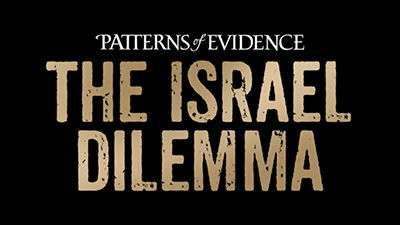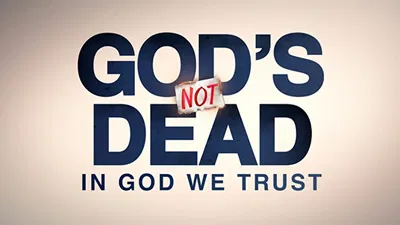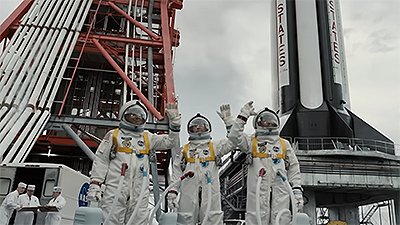Jurassic World: Dominion Review
Living with Dinosaurs
Four years after the events of Jurassic World: Fallen Kingdom which showed the release of all the dinosaurs into the wild, mankind and animals have had to adjust to living with dinosaurs. The underlying assumption is that mankind has never done so before, outside of Jurassic Park (JP) and Jurassic World (JW), but Scripture tells us that man lived with dinosaurs both before and after the flood, with dinosaurs only going extinct within the past few thousand years (or less).
Spoiler Alert: This review reveals certain elements of the movie’s plot, but only to the extent necessary to convey the negative and positive aspects of the film.
Starting with a nod to Deadliest Catch, the opening sequence depicts crab fishermen seeing their entire crab cage taken by a mosasaur, which also capsizes their boat. Other scenes show dinosaurs being used as hunters (of people even, as depicted in previous movies) and the rescuing of dinosaurs that are used and housed unethically, including fighting each other for sport. Predictably, this does not go well.
Typical JP/JW Comeuppance
Compared to other JP/JW movies, the number of human deaths is kept to a minimum and seems almost exclusively reserved for the “bad guys,” including poachers and kidnappers. But there are some cruel, gory, and frightening scenes throughout the movie. Many, particularly children, may find such scenes disturbing. Finally, in a nod (among many) to the original Jurassic Park, a violent death scene, complete with a can of shaving cream, parallels Dennis Nedry’s in JP1.
In these ever-changing scenes are hidden many subtle things you might otherwise miss.
Jurassic World: Dominion is a film filled with fast-paced, chaotic scenery that keeps you on your toes and barely gives you time to think about what you’re viewing. Throughout the film, false narratives are “gently” introduced or enforced. In these ever-changing scenes are hidden many subtle things you might otherwise miss. These include the closing lines regarding the ancient age of the earth and the brief but deceptively impactful line of “dinosaurs are all around us; birds are dinosaurs genetically speaking.”
Let’s briefly look at some of the paleontological accuracies and inaccuracies scattered throughout the film, starting with the non-dinosaurs in order of appearance. NOTE: This list is not exhaustive and does not include modern animals.
- Mosasaurus: This marine reptile, often mistaken as a dinosaur, is the first creature we see in this film. Though it is not a dinosaur, it is truly majestic. However, known representatives of this animal reach a max estimated length of 50–60 feet, not the 100+ feet seen in the film.
- Quetzalcoatlus: This incredibly large pterosaur was massive, though not as big as it is portrayed in the film. Max estimates of this animal’s size give it a wingspan of approximately 35 feet. Another potential inaccuracy is the presence of microfibers, a hair- or feather-like integument that some paleontologists believe these animals had. However, the evidence for such integument on flying reptiles is not conclusive.
- Lystrosaurus: This small reptilian creature makes its debut in a rather unfortunate animal trafficking scene. Aside from the whiskers, this animal’s portrayal is very much in line with our current understanding of how this creature may have looked.
- Dimetrodon: Though this animal is only briefly seen in a few short scenes, its portrayal was surprisingly accurate. Dimetrodon is the first pelycosaur to make an appearance in the Jurassic Park/World franchise.
The Main Attractions
Now for the dinosaurs: aside from the typical oversizing of some of the dinosaurs and the pronated (downward facing) wrists of some of the theropods, most were depicted within the realm of possibility. Let’s focus on the newcomers, as well as the two main staples. NOTE: This list excludes the Iguanodon due to its rarity in scenes and lack of addition to the narrative.
- Velociraptor: Though an icon of these films, the real-world Velociraptor is never seen in the franchise. The animal playing the role is much more similar in both size and skeletal structure to its larger cousin, the Utahraptor.
- Tyrannosaurus rex: “The king of the dinosaurs” resumes its role once again, and aside from being a little too large, it is surprisingly accurate in its depiction—except where it was easily defeated by the Giganotosaurus. These two animals were nearly identical in size, and the “rex” was more suited for combat with other large theropods than the “Giga.”
- Dreadnoughtus: This massive sauropod is seen for the first time on the big screen. However, because of the locality and timing of its real-world discovery, it is very possible that Dreadnoughtus is actually just an Argentinosaurus, which was discovered over 20 years before Dreadnoughtus and shares many similarities.
- Giganotosaurus: While sporting a spiky ridge down its back certainly is cool (and intimidating!), the fossilized skeleton of Giganotosaurus preserves no such structure. This massive theropod is truly one of the largest terrestrial (land-based) predators. However, Spinosaurus is generally accepted to hold that title, and Giganotosaurus, Carcharodontosaurus, and Tyrannosaurus rex roughly tie for second place.
- Moros intrepidus: Though a fierce and intriguing name, the “Harbinger of Doom” is all but fiction. Known only from a few teeth and one partial leg, this animal has almost no record of or any real indicators that it is not a juvenile of an already known species. Lastly, the scant fossil evidence gives no indication of any type of coating; yet in the film, this small creature has a full coat of “dino-fuzz.”
- Atrociraptor: Just like the Moros intrepidus, the Atrociraptor is an animal with next to no fossil evidence. In the case of the “savage thief,” only one partial jaw has been discovered. From this the filmmakers appear to have “created” their own dinosaur. Aside from their slightly smaller size, thicker throat, and a few alterations to the skull, these animals are barely distinguishable from the “Velociraptors” seen throughout the rest of the saga.
- Therizinosaurus: This fan favorite has finally made an appearance, and aside from the unscientific coating of feathers, the depiction of this animal was very well done. From its size to its stance, it is worthy of note that this rendering of the “scythe lizard” was terrifying. Its skull was understandably given artistic license, as it is one of the few parts of this dinosaur that is unknown and is typically based on its smaller cousin, Erlikosaurus.
- Pyroraptor: This animal is the definition of evolutionary storytelling. In a similar story to the Atrociraptor and Moros intrepidus, this animal is known from less than 10 bones and a couple teeth. And yet, somehow the secular scientists go from that to a fully feathered dromaeosaur, with bright plumage, webbed feet, and the ability to swim in freezing water just as gracefully as a penguin. There is no evidence for webbed feet, no evidence for feathers, and dinosaurs in general likely didn’t do so well in such cold temperatures.
In summary, Jurassic World: Dominion hosted several new-to-the-franchise creatures that were fresh and exciting. However, each one of them was used for the glory of evolution rather than for their creator God. Dinosaurs were created by God on day six of the creation week and reproduced after their kind, like all other land animals. They did not evolve into birds, which were created on day five of the creation week.
Dominion
A Corporate Puppet Master
Dr. Ellie Sattler of the 90s Jurassic Park series, investigates giant locusts destroying all crops not biogenetically engineered by a biotech company called Biosyn. This leads Ellie to contact her old friend Dr. Alan Grant (again, a JP original), and she convinces him to join her in a covert operation to see if the locusts were also bioengineered by Biosyn. She contacts Dr. Ian Malcom (another JP main character), who is a lecturer for Biosyn, to infiltate the organization.
Though not intended to represent any particular species of locust, the locusts in the film are very reminiscent of most known locusts. Though none of that size exists today, many insects have extinct relatives that were much larger than their modern-day counterparts, i.e., the giant dragonfly Meganeura.
Jurassic World: Dominion hosted several new-to-the-franchise creatures that were fresh and exciting. However, each one of them was used for the glory of evolution rather than for their creator God.
Jurassic World stars Claire and Owen have reasons of their own to dislike and infiltrate Biosyn, and eventually this leads to the cast of the original Jurassic Park and Jurassic World series to meet up and join the common cause of confronting Dr. Lewis Dodgson, the CEO. Dodgson portrays himself as one who wants to use genetic research to cure disease (a noble aspiration), but he uses unethical means to get what he wants and seems unconcerned with the negative consequences that his decisions inflict on humanity. His instability, perhaps due to a medical condition that is insinuated but not stated, makes his true intentions and aspirations unclear. Somewhat predictably, his role as the main “bad guy” is easily determined.
Contrition and Repentance?
Another original JP cast member, Dr. Henry Wu, appears in the movie, but his character has radically changed since the last time we saw him. Gone is the arrogant and self-serving Wu. He now regrets at least some of the things he’s done and earnestly desires to make some things right. He wants to figure out a way to eliminate the giant locusts as well as use his and others’ genetic prowess to treat diseases.
Wu’s contrition eventually appears to be very real, and the only reason he hasn’t been able to eliminate the locust plague is because Lewis Dodgson won’t allow him to. Wu realizes, unlike in the previous JP/JW movies, that he is not the one in control, and his genetic advancements have been usurped from him.
Final Thoughts
Though a few obscenities and barely noticeable references to adult themes, the main objections in this film are its predictable antibiblical view of the timeline of the earth (past and future) and the roles of both mankind and family, and for violence. Some scenes were hard to watch, and children would likely pick up on some of the antibiblical themes or offscreen violence. We would always encourage discussing any media we consume, particularly as a family, in light of God’s Word.
As the subtitle of this installment of the JW series, dominion plays a key role as the undercurrent of the film. In an odd twist, since the JP/JW series has seemingly always been about mankind having no control (or even the right to have control) over nature, this film kind of pivots to a “mankind needs to exercise stewardship” in order for dinosaurs, animals, and man to coexist together in this new world. Early in the film, Ian Malcolm parrots what has been the mantra for JP/JW movies when he says that humans have no more rights than other animals and are subordinate to nature. But as the film progresses, it is constantly humans who have to care for dinosaurs, help other people, and use whatever technology they can to improve things.
Ironically, and probably without realizing it, they are teaching what God said to Adam and Eve in Genesis 1:28: “Be fruitful and multiply and fill the earth and subdue it and have dominion over the fish of the sea and over the birds of the heavens and over every living thing that moves on the earth.” Even though God said this in a yet-unfallen world, the same principle still applies. We are commanded to be good and faithful stewards (1 Corinthians 4:2).
The movie closes with breathtaking scenes of mosasaurs and whales swimming together, elephants and Sinoceratops running over the plains of Africa together, and the thought that nature, though fragile, will adapt to just about anything, including “ancient” animals being reintroduced (though the insinuation is that it may be at our own peril as humans). While the world does have systems to keep things in balance, we know that it is not “nature” that does this, but rather God’s incredible designs and his sovereignty (including human stewardship). Thanks to God’s mercy and providence, “life will find a way” as long as God wills it.

Answers in Genesis is an apologetics ministry, dedicated to helping Christians defend their faith and proclaim the good news of Jesus Christ.
- Customer Service 800.778.3390
- Available Monday–Friday | 9 AM–5 PM ET
- © 2025 Answers in Genesis




